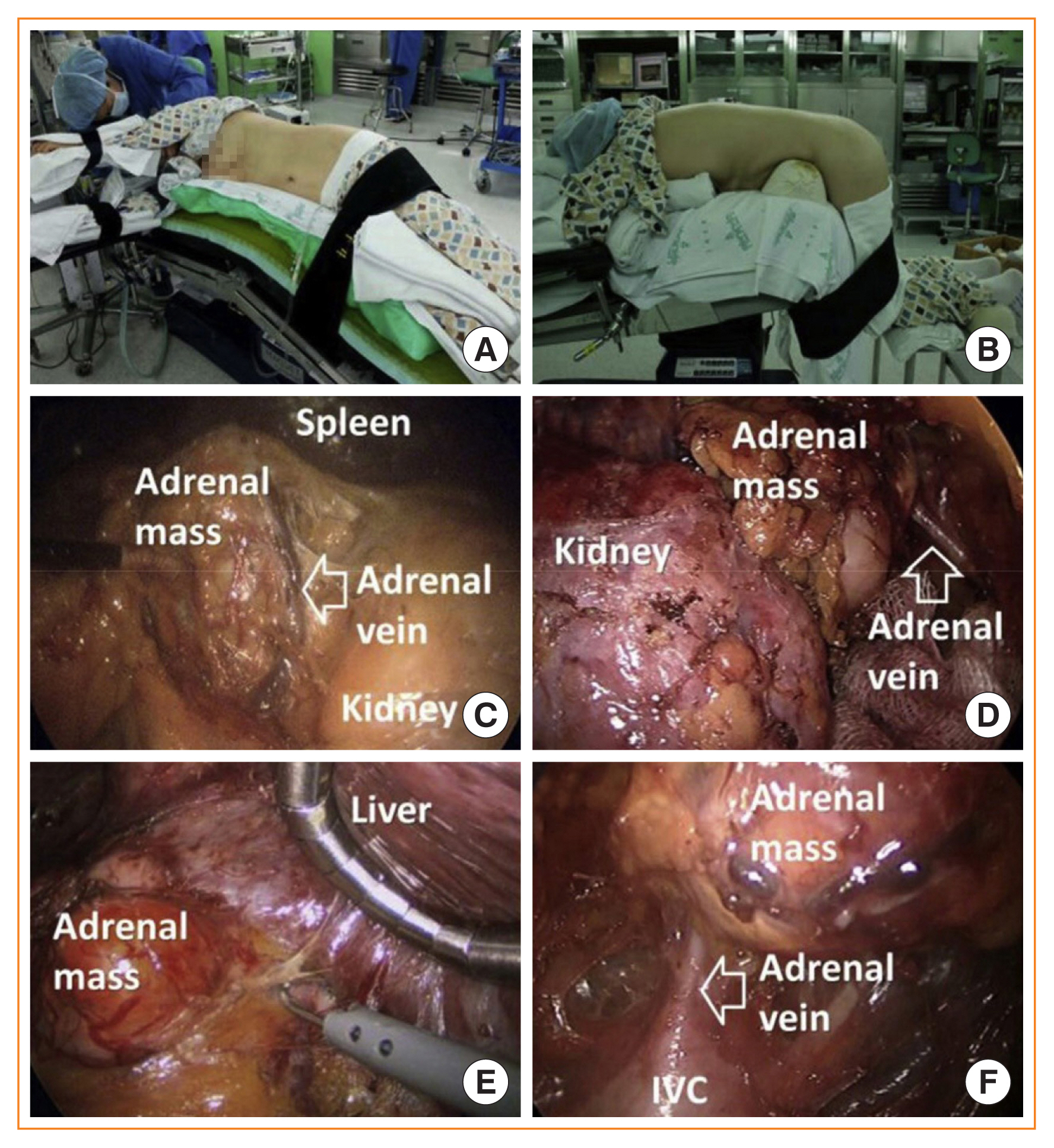Search
- Page Path
- HOME > Search
Review Article
- Adrenal gland
- Minimally Invasive Adrenal Surgery
- JungHak Kwak, Kyu Eun Lee
- Endocrinol Metab. 2020;35(4):774-783. Published online December 23, 2020
- DOI: https://doi.org/10.3803/EnM.2020.404

- 5,089 View
- 155 Download
- 8 Web of Science
- 8 Crossref
-
 Abstract
Abstract
 PDF
PDF PubReader
PubReader  ePub
ePub - Since the introduction of minimally invasive surgery, laparoscopic adrenalectomy has become the main treatment option for adrenal masses. Various studies have reported that laparoscopic adrenalectomy showed fewer postoperative complications and faster recovery than conventional open adrenalectomy. Laparoscopic adrenalectomy can be performed through either the transperitoneal approach or the retroperitoneoscopic approach, which are widely used in most adrenal surgical procedures. Furthermore, with the development of minimally invasive surgery, organ-sparing adrenalectomy has recently emerged as a way to conserve functional adrenal gland tissue. According to recent data, organ-sparing adrenalectomy shows promising surgical, functional, and oncological outcomes including less intraoperative blood loss, maintenance of adrenal function, and low recurrence. Partial adrenalectomy was initially proposed for bilateral adrenal tumors in patients with hereditary disease to avoid chronic adrenal insufficiency. However, it has also gained popularity for the treatment of unilateral adrenal disease involving a small adrenal tumor because even patients with a unilateral adrenal gland may develop adrenal insufficiency in stressful situations. Therefore, partial adrenalectomy has become increasingly common to avoid lifelong steroid replacement and recurrence in most cases, especially in bilateral adrenal disease. This review article evaluates the current evidence on minimally invasive adrenalectomy and organ-preserving partial adrenalectomy.
-
Citations
Citations to this article as recorded by- Treating Primary Aldosteronism-Induced Hypertension: Novel Approaches and Future Outlooks
Nathan Mullen, James Curneen, Padraig T Donlon, Punit Prakash, Irina Bancos, Mark Gurnell, Michael C Dennedy
Endocrine Reviews.2024; 45(1): 125. CrossRef - Modified versus three-level technique of retroperitoneal laparoscopic adrenalectomy for all patients with adrenal lesions ≤ 6cm: a retrospective, case-controlled study
Minxiong Hu, Yangbiao Wu, Xiao Xu, Wenchao Cai, Jiangui Lin, Wanghai Cai, Honghong Pan, Zesong Yang, Liefu Ye, Jinfeng Wu
Frontiers in Endocrinology.2024;[Epub] CrossRef - Ultrasound-guided Transversus Abdominis Plane Block is Effective as Laparoscopic Trocar site infiltration in Postoperative Pain Management in Patients Undergoing Adrenal Surgery
Giuseppe Cavallaro, Sergio Gazzanelli, Angelo Iossa, Francesco De Angelis, Alessia Fassari, Alessandra Micalizzi, Luigi Petramala, Daniele Crocetti, Francesco Circosta, Antonio Concistrè, Claudio Letizia, Giorgio De Toma, Andrea Polistena
The American Surgeon™.2023; 89(11): 4401. CrossRef - Outcome of Partial Adrenalectomy in MEN2 Syndrome: Personal Experience and Systematic Review of Literature
Priscilla Francesca Procopio, Francesco Pennestrì, Carmela De Crea, Nikolaos Voloudakis, Rocco Bellantone, Marco Raffaelli
Life.2023; 13(2): 425. CrossRef - Impact of Current Technology in Laparoscopic Adrenalectomy: 20 Years of Experience in the Treatment of 254 Consecutive Clinical Cases
Giovanni Conzo, Renato Patrone, Luigi Flagiello, Antonio Catauro, Alessandra Conzo, Chiara Cacciatore, Federico Maria Mongardini, Giovanni Cozzolino, Rosetta Esposito, Daniela Pasquali, Giuseppe Bellastella, Katherine Esposito, Ludovico Docimo
Journal of Clinical Medicine.2023; 12(13): 4384. CrossRef - Safety and effectiveness of minimally invasive adrenalectomy versus open adrenalectomy in patients with large adrenal tumors (≥5 cm): A meta-analysis and systematic review
Lijian Gan, Chunyang Meng, Kangsen Li, Lei peng, Jinze Li, Ji Wu, Yunxiang Li
International Journal of Surgery.2022; 104: 106779. CrossRef - Retroperitoneal laparoscopic partial adrenalectomy (RLPA) for 20-40 mm nonfunctional adrenal tumors in the day surgery mode
Xuwen Li, Haibo Xi, Yue Yu, Wei Liu, Xiaoping Zhu, Zhixian Gong, Bin Fu, Gongxian Wang, Xiaochen Zhou
Frontiers in Endocrinology.2022;[Epub] CrossRef - Cirugía laparoscópica en incidentaloma suprarrenal para el cirujano general: serie de casos
Martín Adrián Bolívar-Rodríguez, Marcel Antonio Cázarez-Aguilar, Pedro Alejandro Magaña-Zavala, Francisco Magaña-Olivas, José Martín Niebla-Moreno
Revista Mexicana de Cirugía Endoscópica.2021; 22(1): 8. CrossRef
- Treating Primary Aldosteronism-Induced Hypertension: Novel Approaches and Future Outlooks

Case Report
- A Case of Insulinoma which was treated by Laparoscopic Enucleation.
- Ie Byung Park, Young Jae Oh, Jung Heon Oh, Nan Hee Kim, Sang Jin Kim, Se Hyun Baek, Seob Sub Choi, Sung Ok Seo, Min Kyung Kim
- J Korean Endocr Soc. 1998;13(4):665-669. Published online January 1, 2001
- 1,035 View
- 16 Download
-
 Abstract
Abstract
 PDF
PDF - Insulinoma is a functional endocrine tumor arising from the beta cells of islets of Langerhans of pancreas. The only effective treatment of insulinoma was surgical removal of the tumor. Recently, laparoscopic surgery for islet cell tumors of the pancreas is introduced. Laparoscopic enucleation or resection of benign islet tumors results in a shorter hospital recovery and is a good alternative to open surgery We report a case of insulinoma that was treated sucessfully by laparoscopic enucleation.


 KES
KES

 First
First Prev
Prev



